No matter how the bull and bear markets change, users are always the core. A series of innovations centered around user experience will become the key to the long-term and stable development of the project.
Without participating in Meme, it cannot be said that one has truly participated in this round of bull market.
The Meme craze has been ignited in popular ecosystems such as Solana, Base, and TON, and Meme has become the main narrative of the cryptocurrency market in the first half of 2024. Retail investors are the most active participants and have the best returns. According to CoinGecko data, in the first half of 2024, Meme ranked first in the cryptocurrency race with an astonishing return rate of 1834.22%.
Under the stimulation of high risk and high returns, gaining insight into market dynamics and investment behavior has become a common demand. User-friendly on-chain trend analysis, smart money tracking, and search popularity rankings and other tools have quickly gained popularity in the community through word of mouth. Among them, the Meme mode of the OKX Web3 wallet, which is about to be launched in July, is still in the internal testing phase, but it has sparked discussions within KOLs and the community due to its consistent smooth user experience. As one of the participants in the internal testing, we found during the product experience that the smoothness of the Meme mode is inseparable from the underlying support of the built-in trading aggregator function of the OKX Web3 wallet.
As the main demand of cryptocurrency users, the discussion on the future form of trading products in the industry has never stopped. Delving into the iterative path of the trading function of the OKX Web3 wallet not only provides insights into OKX's consideration of "what kind of trading products users really need," but also analyzes the growth driving force behind its impressive data, to a certain extent, predicting the future trends of trading products.
According to OKX data, the WAU (Weekly Active Users) of the OKX Web3 wallet exceeded 4.6 million last week (including plug-in and mobile terminals), second only to the leading wallet project MetaMask. The weekly trading volume exceeded 381 million USD (including trading, cross-chain, and API), occupying a leading position among various Web3 wallets.
This article aims to delve into the series of functions of the Meme mode that the OKX Web3 wallet is about to launch, on the one hand, by fully entering the OKX Web3 wallet through this mode, it demonstrates how to achieve "reduced friction and efficient aggregation" in trading experience through the built-in trading aggregator OKX DEX. On the other hand, by analyzing the user growth driving force behind the experience, it explores the trends and opportunities of future Web3 trading.
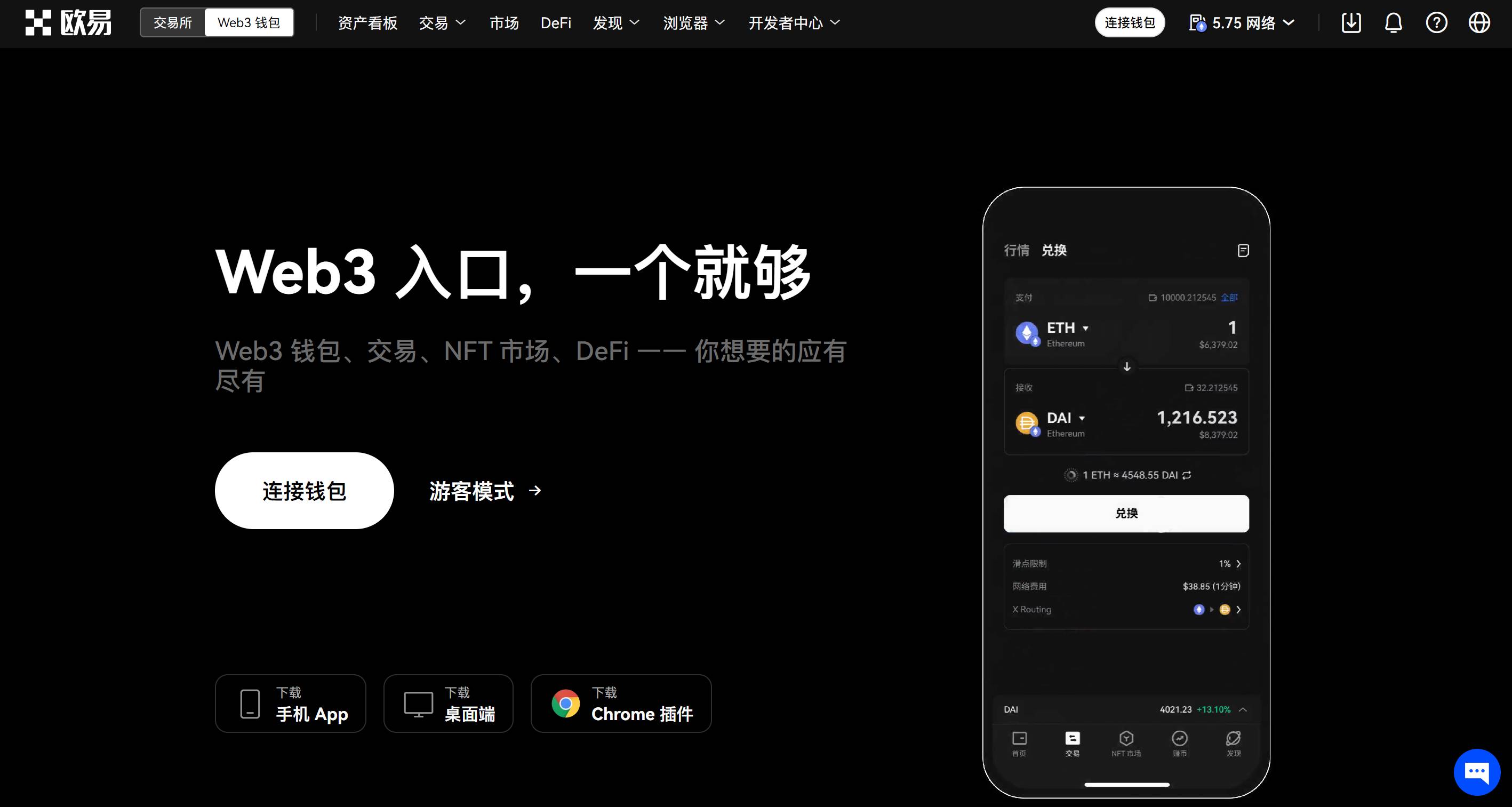
First experience of the Meme mode: Efficient and Free
If Ethereum's last glorious moment belonged to Meme, then the current round of Meme craze cannot be separated from the boost of Solana: whether in terms of quantity or quality, Solana has become the most active public chain for Meme:
According to Dexscreener data, on March 15, 2024, the daily issuance volume on Solana reached an astonishing 9943; from the Silly at the end of 2023, to the widely popular hat-wearing Shiba Inu WIF, and to the BOME that led the innovative pre-sale model with a 50-fold increase on the day of its launch, the Solana ecosystem can be described as a continuous Meme hotbed.
As a public chain known for its performance, Solana's peak transaction volume reaches 65,000 transactions per second, with a block time of only 400 milliseconds. While this lays the foundation for the further prosperity of Meme, it also gives Solana Meme outstanding characteristics: many projects, fast pace, and high risk. In addition, unlike other projects, Memecoins have almost no fundamentals to study. Understanding chip distribution, tracking smart money flow, and whether the project has insider trading are important indicators for evaluating a Meme project. Therefore, trading tools that aim to quickly filter on-chain information for more efficient decision-making and execution have become a common demand for Meme hunters.
As early as March of this year, the OKX Web3 wallet launched the Solana Meme Coin Hunter function, aiming to filter out outstanding "smart money" addresses based on key indicators such as ROI (Return on Investment) and win rate, and track the flow of smart money through intelligent algorithms to push the latest potential investment projects to users, helping them sift through a large amount of information and make more rational investment choices.
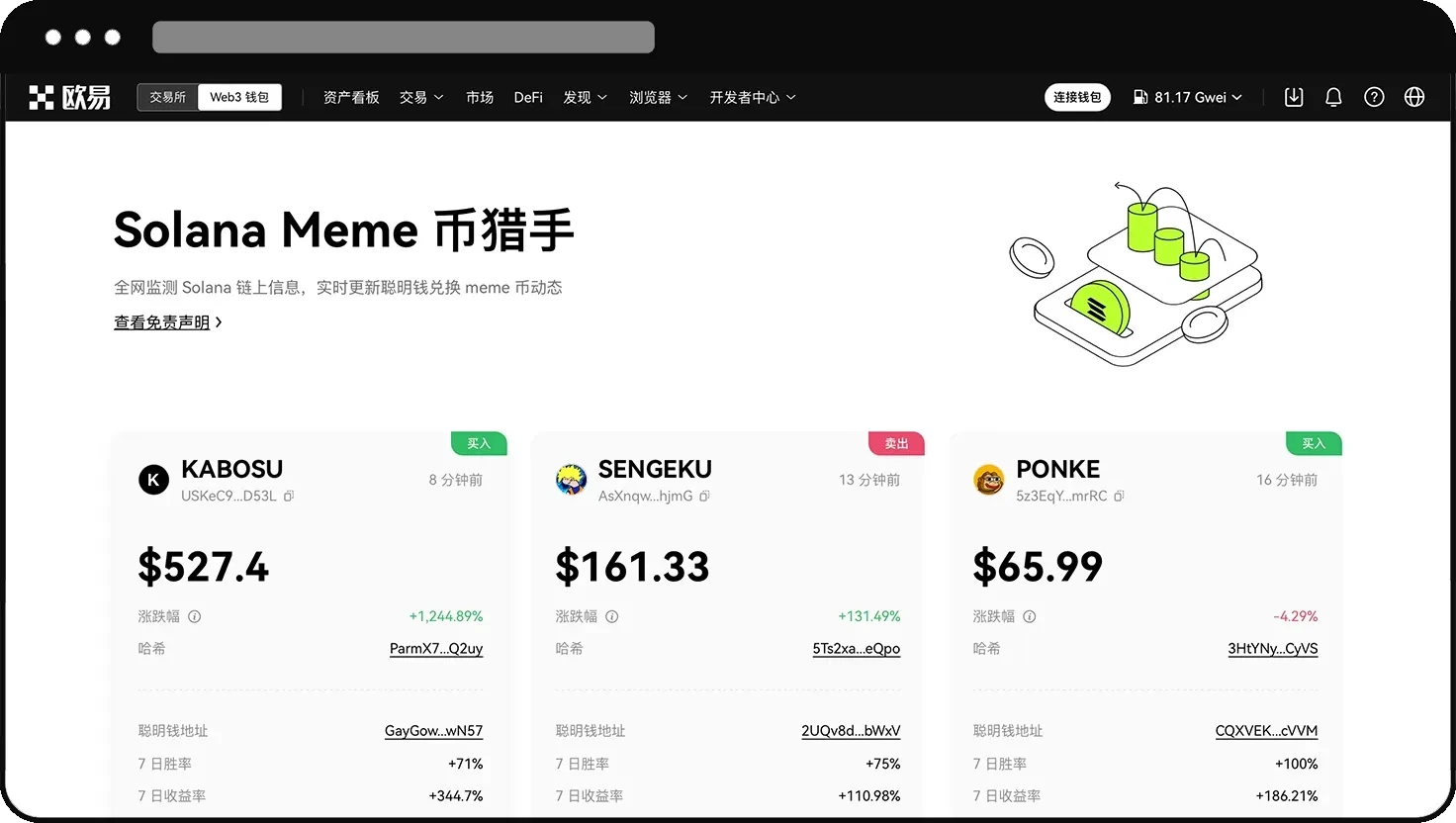
As the Meme craze continues to thrive in the Solana ecosystem, the OKX Web3 wallet has chosen to further tap into the user demand for Meme trading by launching the Meme mode and initiating large-scale internal testing. As one of the invited internal test members, we will now explore the specific functions and advantages of the OKX Web3 wallet's Meme mode.
First, users have two ways to enter the OKX Web3 wallet's Meme mode:
One is to directly enter from the OKX Web3 trading page in the upper right corner: if the user has a balance of a certain token on the Solana chain, they can directly choose that token for trading; if the user wants to trade a new token, they can copy the contract address in advance, paste it into the search box on the page, and add it to achieve quick and efficient trading. The other way is to directly select or search for tokens on the market page and enter the trading page, then click on "Meme Mode" in the lower right corner to enter.
During the trading process, the OKX Web3 wallet's Meme mode defaults to a higher slippage to improve the success rate of the trade. Users can also choose trading parameters (slippage fee rate and priority fee level), or manually input relevant trading parameters, which will be filled in by default for subsequent Meme mode trades. Then click confirm to complete the trade, and both the interaction logic and trading experience are relatively smooth.
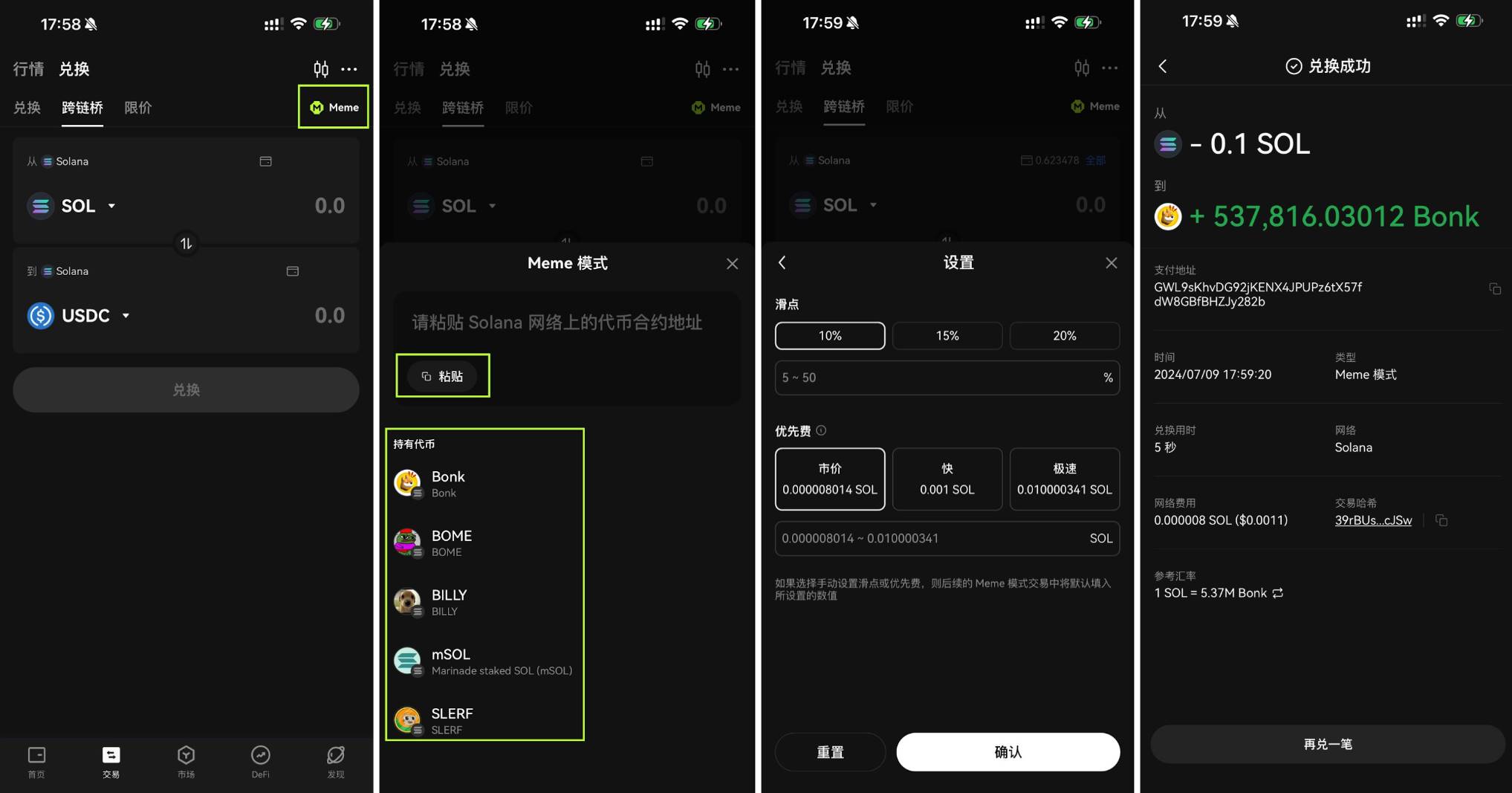
Since the outbreak of the Solana Meme ecosystem, many practical tools have emerged in the market, specifically categorized into project discovery and trading:
Project discovery tools such as Dextools, Dexscreener, and other veteran data websites already support Solana. GMGN provides data dashboards, Pump.fun line chart services, position management, and SmartMoney/KOL wallet exploration functions. On the trading side, users can also choose wallets, DEX, and other platforms. In addition, there are many TG Bots focusing on on-chain address tracking, popular trend coin notifications, and other types of tools to choose from.
In comparison, the advantages of the OKX Web3 wallet's Meme mode lie in faster trading speed, lower trading costs, and the aim to build an integrated Meme experience from value discovery to smooth trading.
We know that time is of the essence in Meme trading, and the lifecycle of a Meme token may only be a few minutes. In Solana, the competition for transaction order is about who arrives at the validator first. In addition, Solana's transaction fees are very low. In order to win priority ordering, bots will send a large number of junk transactions to Solana. Only the first one to be executed in the same transaction will be completed, and the rest will fail. This makes Solana validators consume a large amount of computing resources to process failed transactions.
Previously, the OKX Web3 wallet has optimized for transaction failures, and the Meme mode achieves faster transaction speed through Jito: as the first protocol in the Solana ecosystem to combine MEV and liquidity staking business, Jito increases protocol staking income by introducing mempool and block space auctions, using MEV income as staking rewards, and reducing the occupation of Solana by invalid junk transactions, thereby minimizing the possibility of MEV attacks.
It is worth mentioning that, compared to most Bot tools that charge around 1% in trading fees (for example, BonkBot, as the most popular trading Bot, had a daily income of up to 1.3 million USD in March this year), the OKX Web3 wallet's Meme mode does not charge any fees other than slippage and priority fees, and by sharing this part of the income with users, the OKX Web3 wallet aims to provide users with a more efficient and cost-effective Meme trading experience.
In addition, the Meme mode of the OKX Web3 wallet is built on the OKX Web3 decentralized wallet, which further enhances user security and autonomy in this non-custodial mode.
After the internal testing, the Meme mode of the OKX Web3 wallet will soon be available to everyone. As a powerful assistant for Meme hunters, the Meme mode of the OKX Web3 wallet aims to help more users capture more opportunities and achieve higher returns in the fast-paced, high-risk market, from value discovery to cost reduction and experience enhancement. Interested readers can explore and experience it for the first time. Of course, Meme price fluctuations are drastic, and trading carries high risks. Although the Meme mode of the OKX Web3 wallet aims to help miners efficiently screen opportunities, investing in Meme still requires caution.
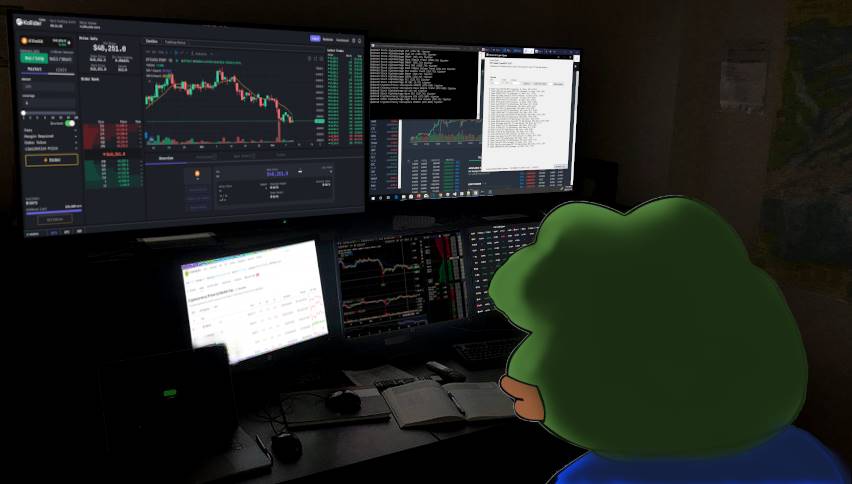
User Growth from Trading Demand: Low Threshold and High Aggregation Have Become a Trend
As mentioned at the beginning, we found that the widespread praise for the Meme mode is inseparable from the underlying support of the built-in trading aggregator function of the OKX Web3 wallet. The extensive user reputation seems to have proven that in the face of the question "what kind of trading products do users really need," the OKX Web3 team has grasped the core of user demand, and what is this core?
We attempt to find some clues about the answer from the evolution and development trends of trading products. Looking back to the brilliant summer of 2020, a wave of trading projects represented by Compound, Uniswap, Sushiswap, and Curve kicked off DeFi Summer, and on-chain trading volume and the number of users experienced explosive growth. According to Defillama data, compared to the beginning of 2020, DEX trading volume grew nearly 200 times by the end of 2020. Subsequently, Ethereum's congestion and high gas fees gave rise to the emergence of new public chains and Layer 2 solutions, and top trading products built on various chains also performed exceptionally well. During this explosive growth, we also observed various trends in user demand for trading products:
1. The Advantages of Aggregated Trading Products Are Becoming More Prominent
The continuous increase in the number of trading products on different chains not only means that liquidity is becoming more and more dispersed, but also means that the swap prices and costs of different pools differ. For users, finding the optimal swap path is not only a challenge of information filtering but also an opportunity to capture profits. In light of this, the advantages of aggregated trading products have become increasingly prominent: the solitary struggle of a single DEX product seems more like a wedding dress for aggregated DEX products. By aggregating a series of DEX protocols and comparing exchange rates to recommend the optimal swap path to users, aggregated trading products greatly save users the work of comparing various DEX platforms.
With these advantages, we can see the rapid development of aggregated products in recent years: In June 2024, the total trading volume of the Solana ecosystem's DEX aggregator Jupiter exceeded 200 billion USD, accounting for over 80% of the Solana DEX trading volume.
In this regard, the core design concept of the "All in One" product of the OKX Web3 team coincides with the trend of aggregated trading products:
The built-in trading aggregator function (OKX DEX) of the OKX Web3 wallet aims to automatically calculate the optimal trading path in multi-chain and cross-chain scenarios through intelligent routing algorithms, providing users with quotes with lower slippage and fewer network fees. Compared to general aggregated products, the OKX Web3 team excels in being "more comprehensive and more efficient."
As the only DEX that combines aggregator SWAP and cross-chain bridge Bridge in the market, the current built-in trading aggregator function of the OKX Web3 wallet has aggregated 400+ mainstream DEX and 25+ cross-chain bridges, and supports 30+ mainstream/popular/emerging blockchains including Bitcoin, Ethereum, Solana, and Base.
In terms of efficiency, OKX DEX achieves millisecond-level quotes through its self-developed X-Rooting algorithm. While most DEX platforms are still promoting second-level quotes, the OKX DEX API achieves a response time of less than 100 milliseconds, meaning that OKX DEX has completed at least 4 responses in the time it takes to blink an eye. Faster quotes not only mean that users can obtain the best prices in real-time, helping traders to react quickly to market price fluctuations and execute trades rapidly, but also mean support for more complex trading strategies such as arbitrage trading and algorithmic trading, enabling professional traders to execute their strategies more effectively, thereby further enhancing the platform's liquidity and market depth, truly bringing a smooth and efficient experience comparable to CEX to DEX trading.
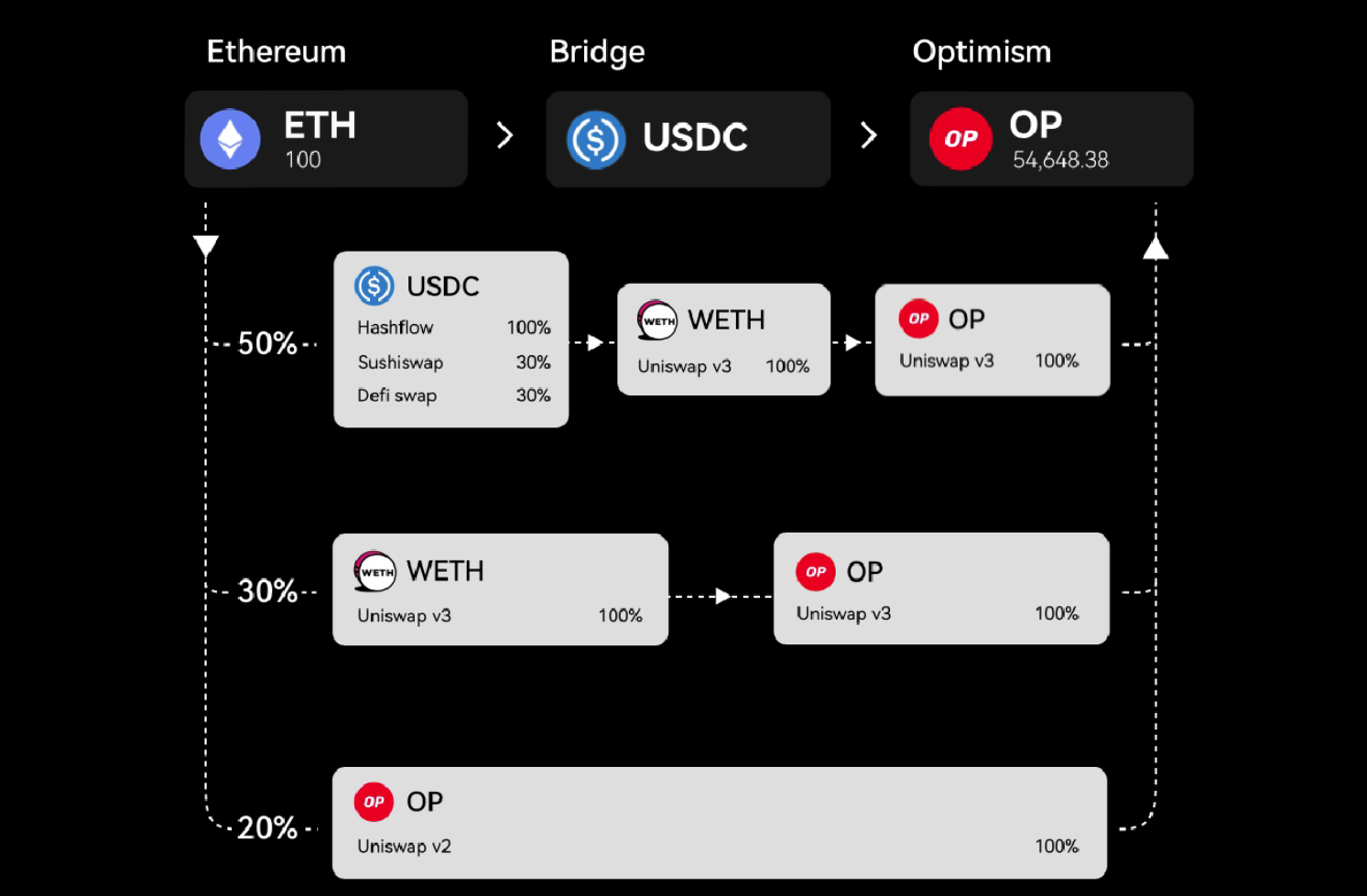
2. Trading Experience as the Key to User Growth
User experience can be said to be a problem that has always existed but has never been well resolved.
The DeFi explosion in 2020 did greatly expand the scale of cryptocurrency users, but the trading experience during this period was non-existent, and only high returns stimulated a large number of users to spend time learning the complex operational logic of the crypto world. With Ethereum's congestion and gas fee issues, users began to spontaneously shift to new public chains and L2 solutions with better performance and cost advantages. According to Defillama data, on December 15, 2023, the DEX trading volume on the Solana chain surpassed Ethereum, which had long dominated the first place.
After several years of development, with saturated demand from existing users and the industry seeking incremental users, reducing barriers and enhancing the experience has become a consensus for breaking the barriers of the Web3 ecosystem. Solutions such as account abstraction have emerged, and many Web3 wallets continue to explore reducing barriers. For example, in February 2024, Coinbase announced the concept of its smart wallet at ETHDenver and provided a test version for developers, allowing users to create wallets using Passkey (Face ID, Google Chrome profiles, etc.).
In terms of reducing barriers, the OKX Web3 wallet features functions such as iCloud/Google Drive backup of mnemonic phrases, MPC non-private key wallets, and AA smart contract wallets, greatly reducing the cost of private key recovery and reducing user friction. In terms of experience, among the Web3 wallets launched by various leading exchanges, the OKX Web3 wallet's exploration of AA smart contract wallets is the earliest and most in-depth. Currently, OKX supports users in creating AA smart wallets on 8 popular blockchains including Ethereum, OKTC, and Arbitrum.
In addition to reducing barriers, another component of a good user experience is reducing friction to make trading more flexible and smoother. In terms of this optimization, we can see that chain abstraction aimed at enhancing interoperability has received much attention, and UniswapX has implemented gas-free transactions. The OKX Web3 wallet has also designed a gas exchange function for novice users, allowing users to quickly exchange mainstream assets such as USDT, USDC, DAI, and WETH for gas fees. Even if users do not have gas or have insufficient gas during actual trading, they can smoothly complete the transaction without leaving the trading page, greatly simplifying and enhancing the user's cross-chain trading experience.
Additionally, the built-in trading aggregation function of the OKX Web3 wallet also supports limit order trading and custom slippage. Users can preset their desired buy or sell prices, and once the market price reaches or exceeds this price, the order will be automatically executed. They can also set price ranges more precisely to better control risks and execute strategies, providing users with greater flexibility for their trading strategies.
In furthering the realization of the vision of "one entry to play the entire Web3 ecosystem," the OKX Web3 ecosystem aims to cover various application scenarios from DeFi, NFT, games, RWA, and more, starting from the wallet and using trading as the pivot, to provide users with a smooth, rich, efficient, and low-cost interactive experience. The OKX Web3 wallet currently supports 95+ public chains and 1000+ dApps, allowing users to easily participate in various investment activities in 200+ DeFi protocols through the wallet's DeFi module to earn profits, engage in NFT trading on 20+ networks through the wallet's NFT market module, and even explore early high-quality projects and participate in interactive activities to potentially earn profits and stay informed about Web3 offline events through the Dapp exploration page. Additionally, with the smooth cross-chain swap function, users can eliminate concerns about cumbersome operations.
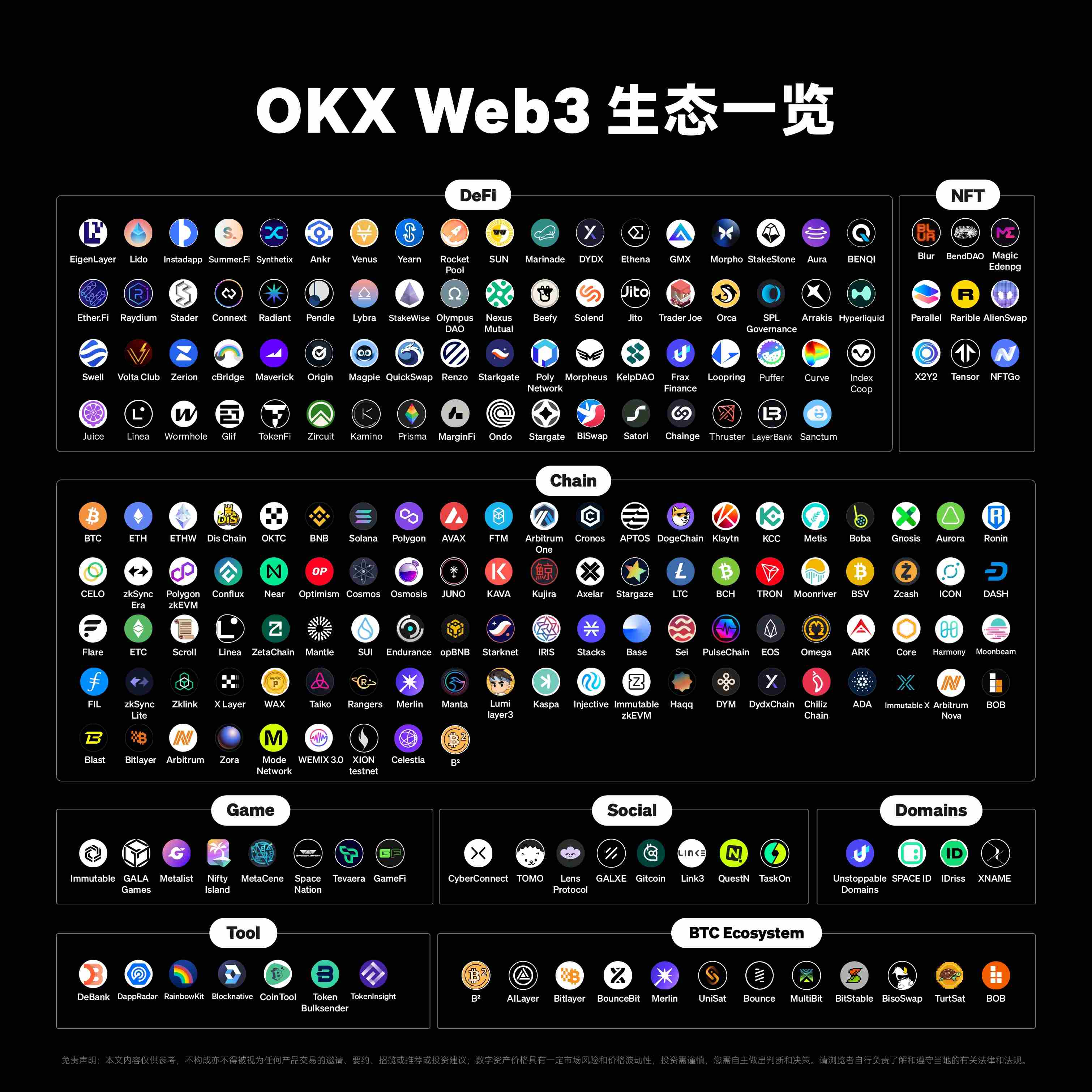
3. Iterating Trading Features Needs to Keep Up with Market Trends
This point is not difficult to understand because market trends inherently attract a large amount of user attention. By closely following market trends and providing relevant support based on user demand, users who are interested in these trends are likely to become product enthusiasts. However, in order to keep up with market trends, it not only requires the market team to have keen insights into the community but also requires the technical team to respond quickly to demands.
In 2023, during the DeFi Summer, the phenomenon of achieving user growth by seizing the hot trend of DeFi was repeatedly demonstrated. For example, the first Bitcoin-based Ordinals open-source browser extension wallet, Unisat, experienced a surge in users as the only on-chain entry point for the BRC token during the severe lack of Bitcoin ecosystem infrastructure: according to data from the UniSat Wallet's Google Chrome store in May 2023, the weekly active user count of UniSat Wallet exceeded 300,000, compared to only 272 three months earlier, achieving over a hundredfold increase.
If Unisat showed the community more possibilities for DeFi, then the OKX Web3 wallet, which joined the DeFi battlefield later, can be said to have created a "everyone plays DeFi" scene through its mature product: at the end of May 2023, the OKX Web3 wallet fully launched the Ordinals market, quickly becoming a well-regarded "easy-to-use wallet" in the DeFi ecosystem due to its smooth product experience, comprehensive features, optimal liquidity, and zero fees. Subsequently, the OKX Web3 team capitalized on this momentum by introducing batch engraving, EVM DeFi ecosystem support, and other features, leading to a rapid increase in market share, with the peak trading volume reaching close to 90% on December 18, 2023.

According to Dune data, among various Web3 wallets, the OKX Web3 wallet experienced rapid growth in May 2023. We can see that this growth driven by market trends is sustainable: as shown in the graph, while the market share of the MetaMask wallet is decreasing, the market share of the OKX Web3 wallet is continuously rising after the DeFi trend. This is partly due to the multi-chain advantage of the OKX Web3 wallet, which attracted and cultivated user habits through the DeFi trend, making users more inclined to use the OKX Web3 wallet to manage multi-chain assets. Another reason is that the silky smooth user experience based on user demand truly retains users in the OKX Web3 ecosystem.
In 2024, with the increasing popularity of Meme, the upcoming Meme mode of the OKX Web3 wallet is expected to bring about a new round of user growth for the OKX Web3 ecosystem.
The Road to One Billion Users: Multi-dimensional Exploration of Web3 Trading Infrastructure
Although trading products have undergone several iterations in reducing barriers, eliminating friction, and improving efficiency, and user experience has been greatly optimized compared to the DeFi Summer period, it must be acknowledged that there is still much that Web3 trading can do to achieve one billion on-chain users.
Firstly, in terms of the scale of on-chain users: according to Crypto.com's market size report, the global cryptocurrency user count increased by 34% in 2023, from 432 million to 580 million, which is an encouraging growth. However, another set of data worth noting is that the active users on the top 20 L1 chains are only close to 75 million, and the largest monthly active data on L2 is still slightly below 20 million. Overall, among the 580 million cryptocurrency users, there is still a huge growth potential for true on-chain users.
As for bridging the gap in user volume, let's return to the initial question: what kind of trading products do users really need?
Since the subject of the question is users, perhaps the answer can also be provided by users. Quoting the community's comments on the OKX Web3 wallet and its trading aggregation function:
"Smooth interaction in low barriers, capturing opportunities in efficient aggregation."
The iterations of the OKX Web3 wallet will also revolve around low barriers and high aggregation: on one hand, the OKX Web3 wallet will explore the implementation of OMNI Gas, further simplifying the trading process and avoiding additional trading costs; on the other hand, the intent trading mode feature was previously integrated by OKX DEX through UniswapX, and will explore more innovative possibilities in the future. Additionally, the built-in trading aggregation function of the OKX Web3 wallet will continue to optimize algorithms and aggregate more DEX protocols and cross-chain bridges, aiming to provide users with more comprehensive aggregation and faster quotes.
It is worth mentioning that in the face of the macro-narrative of one billion users, OKX Web3 is more inclined to carry forward the open-source spirit of Web3: in the future, it will provide system construction services (Waas) to the industry and package the wallet, DEX, and other infrastructure and upper-layer interfaces into easy-to-use and programmable SDK and API interfaces, providing a one-stop SDK and API access solution, aiming to help more developers join in building Web3.
Furthermore, for the topic of incremental users in the Web3 ecosystem, as leading exchanges successively launch Web3 wallet features, on-chain users in the Web3 ecosystem may experience rapid growth: on one hand, trading is the first point of contact for most ordinary users entering the crypto industry, and among the 580 million cryptocurrency users, exchanges, especially leading exchanges, hold the vast majority of users. By deploying Web3 wallets at the entry points of exchange apps, the transition from exchanges to Web3 wallets is smoother for users. On the other hand, leading exchanges have top-tier products, technical teams, operational teams, and rich ecosystem resources, which not only make it easier to integrate resources but also gradually shape the Web3 product experience from a more professional and precise perspective.
As a leading exchange, OKX announced its transition to the Web3 path as early as 2021. This forward-thinking strategic decision allowed OKX to establish its presence in the Web3 field ahead of many competitors. With this advantage, the OKX Web3 team began researching Web3 user trading needs and exploring product forms several years ago, leading to the OKX Web3 wallet's leading market performance in terms of trading volume, user base, and product experience. This also provided experience and examples for later entrants in the design of trading products.
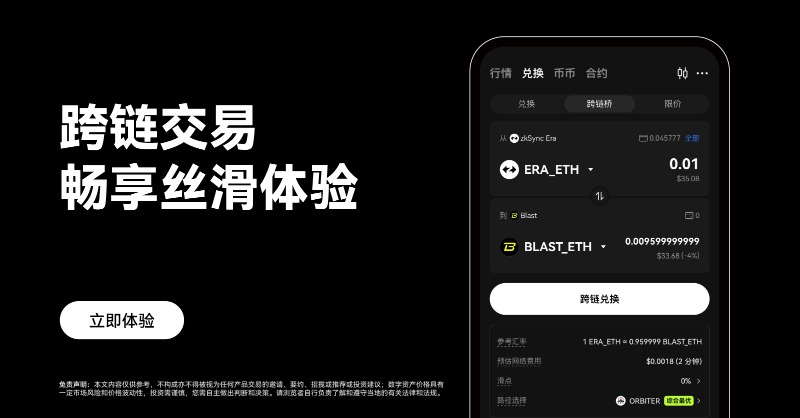
Conclusion
As the core demand of Web3 users, trading infrastructure competition is becoming increasingly fierce.
It is undeniable that from wallets to DEX, the OKX Web3 team seems to always be shaping the standard form of Web3 products: when Web3 user experience was still in its infancy, the OKX Web3 team was at the forefront of exploring smooth and efficient product interaction experiences. Even when everyone was praising the usability of the product upon its launch, the OKX Web3 team remained focused on bringing innovations based on user needs.
Regardless of market fluctuations, users are always the core, and a series of innovations centered around user experience will be the key to the long-term and stable development of projects. We look forward to seeing more innovative achievements emerging from pioneers like OKX Web3 and the entire industry.
免责声明:本文章仅代表作者个人观点,不代表本平台的立场和观点。本文章仅供信息分享,不构成对任何人的任何投资建议。用户与作者之间的任何争议,与本平台无关。如网页中刊载的文章或图片涉及侵权,请提供相关的权利证明和身份证明发送邮件到support@aicoin.com,本平台相关工作人员将会进行核查。




